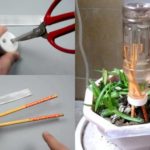Creative Hacks
In the hustle and bustle of daily life, embracing the potential of repurposing everyday items can yield both convenience and environmental benefits, such as cutting a plastic bottle in half and placing it in the kitchen sink. With this simple tweak, a common kitchen conundrum is solved “in a jiffy.”
What’s the Power Behind a Halved Plastic Bottle in the Kitchen Sink?
To begin this plastic bottle repurposing project for your sink, arm yourself with a knife or scissors to cut the bottle in half.
Using a sharp nail, melt its tip over a flame and use it to puncture 5-6 drainage holes at the bottom of the bottle, and add 2 additional holes near the top for hanging wire. If a nail is unavailable, employ a piece of steel wire instead.
Next, thread a wire through the two holes punched in the bottle and secure the ends to create a handle for hanging; affix a hook at a corner of the sink and suspend the plastic bottle from it.
By employing this halved plastic bottle technique, you unlock a multitude of benefits, as detailed below:

Here’s a perk of using a halved plastic bottle in the kitchen sink. (Image: Cleverly.me)
Acts as a Food Waste Collector
A valuable hack facilitated by the repurposed plastic bottle is its use as a food waste collector during dishwashing.
Post-meal clean-ups often result in food remnants, which many tend to dispose of directly into the sink. However, the small size of most sink strainers limits their capacity, leading to rapid accumulation, slower drainage, and an increased risk of clogging.
To alleviate this issue, simply place the halved plastic bottle inside the sink. While washing dishes, discard food scraps into the bottle. Excess water from the scraps drains out through the holes you created earlier. The bottle’s ample diameter eases the disposal process and accommodates larger quantities of food waste.
Once it’s full, just remove the bottle, empty it into a trash bag, rinse it, and reattach it to its designated spot.
Kitchen Tool Holder
Once your plastic bottle is halved and repurposed in the sink, it can transform into a storage solution for your sponge and steel wool. The drainage holes allow excess water from these tools to drain out, keeping them dry and discouraging bacterial growth. This space-saving technique contributes to a tidier and more organized kitchen.
To craft this tool holder, snip off the bottle’s top and set it aside, then cut a rectangular section from the middle of the bottle and discard it. Invert the top section and attach it to the bottle’s bottom. Now, your kitchen sponge has a dedicated spot, preventing it from resting on dirty surfaces and dripping everywhere.
Liquid Soap Dispenser
The uncut half of your plastic bottle can be utilized as a convenient dispenser for dishwashing liquid. Simply fill it with a diluted mixture of dish soap and water for your daily dishwashing needs. Not only does this save money, but it also reduces chemical waste, benefiting the environment.
Additional Creative Uses for Plastic Bottles
Beyond their repurposing in kitchen sinks, plastic bottles offer a multitude of other practical applications in everyday life, including:
Gardening
Cut bottles in half and employ their bottom portions as plant pots. This not only reduces plastic waste but also creates handy mini planters for indoor or outdoor gardening.

Ingeniously repurposing empty plastic bottles into useful and visually appealing items like flower pots (Image: Cleverly.me)
Food Storage
Plastic bottles can hold food items such as sugar, salt, rice, and other pantry staples. They provide airtight storage, protecting contents from external factors like humidity and insects.
Kitchen Utensil Holder
Plastic bottles can organize kitchen tools like chopsticks, spoons, knives, and other miscellaneous utensils. This approach keeps the kitchen tidy and the necessary items within easy reach.
Oil and Liquid Storage
Plastic bottles can store oils, soaps, and other household liquids. They offer a convenient way to keep liquids organized and accessible without purchasing separate containers.
School and Office Supplies
Plastic bottles can find use in educational or office settings, serving as pen holders, card organizers, and other classroom or workspace essentials.
Evidently, aside from using a halved plastic bottle in the kitchen sink, you have numerous options to repurpose it, keeping it out of landfills and minimizing environmental impact.
Source: VTC NEWS

































